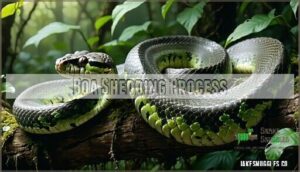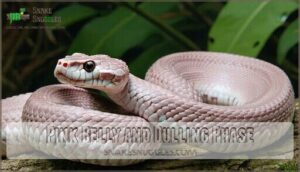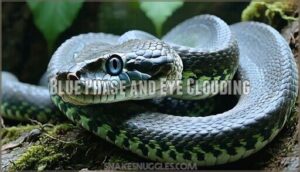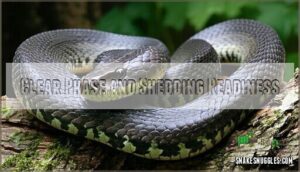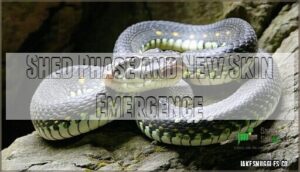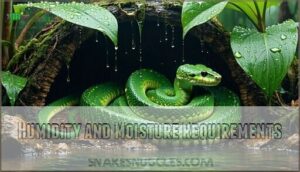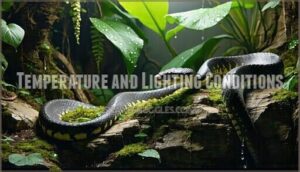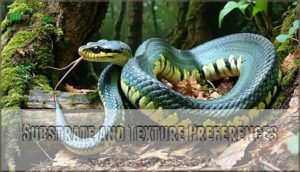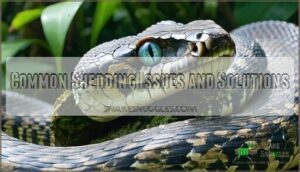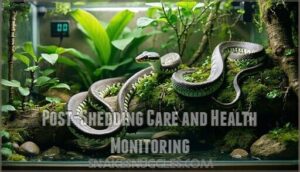This site is supported by our readers. We may earn a commission, at no cost to you, if you purchase through links.
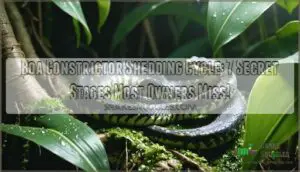
Young boas shed every 4-6 weeks, while adults shed every 2-4 months.
The cycle begins when your snake’s belly turns pink and skin dulls, followed by the distinctive "blue phase" when eyes cloud over.
You’ll notice your normally social snake becoming reclusive during this vulnerable time.
Proper humidity (60-80%) is essential for a clean shed—think of it as nature’s spa treatment for your serpent.
Temperature and diet also influence the boa constrictor shedding cycle.
The seven distinct stages reveal fascinating insights about your snake’s health that many owners overlook.
Table Of Contents
- Key Takeaways
- Boa Shedding Process
- Shedding Stages Explained
- Environmental Factors Affecting Shedding
- Common Shedding Issues and Solutions
- Post-Shedding Care and Health Monitoring
- Frequently Asked Questions (FAQs)
- How do I tell if my boa is shedding?
- What are the signs of a reptile going through a shed cycle?
- Does shedding mean my snake is growing?
- Why are boa constrictors more unpredictable in a shed cycle?
- How often do boa constrictors shed their skin?
- Why are boa constrictors so unpredictable?
- How fast do boa constrictors grow?
- How to care for Boa constrictors?
- How often should boa constrictors be fed?
- How often do boa constrictors shed?
- Conclusion
Key Takeaways
- You’ll notice your boa’s shedding process begins with a pink belly and dulling skin, followed by the distinctive "blue phase" when eyes cloud over, signaling you shouldn’t handle your snake during this vulnerable time.
- You need to maintain proper humidity levels (70-80% normally, increasing to 80-90% during shedding) to prevent common issues like stuck shed, retained eye caps, and potential health complications.
- You should adjust your care routine during shedding by delaying feeding, providing rough surfaces for rubbing, and monitoring for signs of dehydration or respiratory issues that can develop from improper conditions.
- You’ll find that shedding frequency varies with age—young boas shed every 4-8 weeks while adults shed every 2-3 months—serving as a natural indicator of your snake’s growth, health, and overall well-being.
Boa Shedding Process
You’ll notice your boa’s periodic shedding cycle differs dramatically from mammals, as they cast off their entire skin in one continuous piece rather than shedding continuously.
Your snake’s shedding process follows distinct stages that signal its health and development, with younger boas typically shedding every 4-8 weeks while adults shed less frequently at intervals of 2-3 months, which indicates their development and overall well-being.
Signs of Impending Shed
You’ll notice clear signs before your boa starts shedding.
Watch for dull skin losing its luster and cloudy eyes turning a milky blue-white color about 7-10 days before the actual shed.
Your snake will show reduced activity, appetite loss, and behavior changes like increased defensiveness.
The skin becomes slightly saggy, especially around the head and neck, and these shedding signs help you prepare for the upcoming process, which involves recognizing key changes such as dull skin.
Shedding Frequency and Age
After spotting those early shedding signs, you’ll want to understand how often your boa will actually shed.
Your boa’s age directly impacts shedding frequency.
Young boas shed every 4-8 weeks due to rapid growth, while adults typically shed only every 2-3 months.
As they age, this frequency slows even further.
Diet, individual variation, and environmental factors all influence how often your snake sheds its skin.
Maintaining stable conditions helps support healthy shedding cycles, which is crucial for your boa’s overall health, particularly during rapid growth and environmental changes, and ensuring healthy development.
Factors Influencing Shedding
Your boa’s shedding lifecycle depends on multiple factors beyond just age. Understanding these elements helps you predict and manage the process better.
- Dietary Impact: Larger or more frequent meals can accelerate shedding frequency
- Age Influence: Younger boas shed every 4-8 weeks; adults every 2-3 months
- Health Status: Illness may trigger irregular shedding patterns
- Hydration Levels: Proper humidity prevents stuck sheds
- Genetic Factors: Some boa varieties naturally shed more frequently due to their genetic makeup and hydration levels.
Pre-Shedding Care and Preparation
As your boa’s shedding cycle approaches, you’ll need to adjust your care routine.
Watch closely for dulling skin and blue eyes, signaling the pre-shedding phase has begun.
Maintaining proper humidity is essential, and you can even research boa humidity enclosures to help with this.
| Pre-Shedding Action | Why It’s Important | When to Implement |
|---|---|---|
| Humidity Increase | Prevents stuck shed | When eyes turn blue |
| Feeding Adjustments | Prevents regurgitation | Delay until after shed |
| Handling Avoidance | Reduces stress | During blue phase |
| Surface Provision | Aids shedding process | Throughout enclosure |
| Observation Tips | Monitors progress | Daily checks |
The table outlines key actions to take during the shedding cycle, including humidity increase, feeding adjustments, handling avoidance, surface provision, and observation tips.
By following these guidelines and maintaining a careful eye on your boa’s condition, you can ensure a healthy and successful shedding process.
Shedding Stages Explained
You’ll notice your boa progresses through specific stages during shedding, from the initial pink belly phase to the final emergence of fresh skin.
Each stage has distinct characteristics that can help you anticipate your snake’s needs and prevent common shedding problems, particularly by recognizing the complete concepts of shedding stages.
Pink Belly and Dulling Phase
The first subtle indicators of your boa’s shedding cycle appear during the pink belly and dulling phase.
You’ll notice a uniform pink color developing on your snake’s belly, which is one of the initial indicators of preshedding activity.
Snakes undergo the process of ecdysis to replace their old skin.
- Pink intensity varies by snake, with lighter-colored boas showing more pronounced pinkness
- Skin loses its characteristic shine and becomes noticeably duller
- Identifying subtleties early allows for timely humidity adjustments to support the ecdysis process and ensure a healthy pink belly phase.
Blue Phase and Eye Clouding
After your boa’s skin has dulled, you’ll witness the dramatic blue phase.
During this stage, your snake transforms with cloudy eyes and a milky blue-white color covering its body.
This opacity results from fluid buildup between old and new skin layers.
Your boa experiences significant vision impairment now, making it more defensive and prone to striking.
The blue phase duration varies—lasting anywhere from two days to a full week—so maintain 80-90% humidity to prevent shedding difficulties and ensure a healthy shedding process.
Clear Phase and Shedding Readiness
After the milky blue-white color fades from your boa’s eyes, you’ve reached the clear phase—an overlooked stage many owners miss.
During this brief period, your boa’s skin becomes translucent as it prepares for the final shed.
- Visual cues include brightening eyes returning to normal
- Skin appears stretched and glossy
- Shed timing typically occurs 24-48 hours after clear phase begins
- Handling risks increase as skin is extremely fragile now
- Snake behavior changes—many become more active before shedding, which can be a critical time to monitor their snake behavior.
Shed Phase and New Skin Emergence
After your boa’s eyes clear, it’s showtime! The actual shed phase happens when your snake actively removes its old skin, ideally in one piece.
You’ll notice increased rubbing against rough surfaces as your pet works to achieve perfect sheds. Post-shed behavior typically includes renewed activity and exploration.
The vibrant colors of fresh skin emerge, showing improved skin integrity, and it’s crucial to monitor shed completion carefully, ensuring no pieces remain, especially around eyes and tail tip.
Environmental Factors Affecting Shedding
You’ll find that your boa’s shedding process depends heavily on the environment you provide, with humidity levels and temperature being the most critical factors.
Creating ideal conditions with proper humidity (70-90%), appropriate temperatures, and textured surfaces will help your snake shed completely in one piece, preventing health issues that can arise from incomplete sheds, which is crucial for maintaining your boa’s overall health.
Humidity and Moisture Requirements
Every successful boa shed depends on proper humidity levels in your enclosure.
Maintain 70-80% humidity consistently for your boa, increasing to 80-90% during the blue phase.
Improper humidity leads to shedding problems like stuck eye caps and incomplete sheds.
Instead of frequent misting, use humidity-retaining substrates like EcoEarth.
Maintaining proper humidity can be achieved with specialized reptile products.
Consider alternative hydration methods such as a large water dish or humidity hide to prevent dehydration while supporting your boa’s shedding cycle.
Temperature and Lighting Conditions
During the shedding process, maintaining proper temperature and lighting conditions is essential for your boa.
Here’s an engaging blockquote that maintains the same informative, direct tone as the original paragraph:
Precise temperature and lighting aren’t just preferences—they’re essential foundations for your boa’s successful shedding journey.
Create a heat gradient with a basking spot of 88-92°F and night temperatures around 75-80°F.
While UVB lighting isn’t essential for boas, it can provide benefits.
Always use a thermostat to regulate heating elements like infrared heat panels.
Proper temperature regulation directly impacts humidity levels and your boa’s ability to shed successfully.
Substrate and Texture Preferences
Your boa constrictor’s smooth shedding process depends heavily on the right substrate and textures in its enclosure.
Proper substrate choices directly impact humidity retention and successful skin removal.
For ideal shedding aid, provide:
- 2-4 inches of moisture-retentive substrate like cypress mulch or coconut husk
- Natural textures such as cork bark and wood pieces for rubbing
- Layered sphagnum moss to maintain consistent humidity levels
Avoid pine and cedar substrates, which contain oils that can irritate your boa’s sensitive skin.
Enclosure Maintenance and Hygiene
While providing the right textures helps your boa shed properly, maintaining clean enclosure conditions is equally important.
Regular hygiene practices directly impact successful shedding cycles.
| Cleaning Task | Frequency | Impact on Shedding | Humidity Effect |
|---|---|---|---|
| Spot cleaning | Daily | Prevents skin infections | Maintains stable levels |
| Water bowl refresh | Every 2-3 days | Supports hydration | Creates moisture source |
| Full substrate change | Monthly | Removes bacteria | Refreshes humidity retention |
| Deep disinfection | Quarterly | Eliminates pathogens | Resets enclosure conditions |
Common Shedding Issues and Solutions
You’ll encounter several common shedding problems with your boa constrictor, including stuck shed, retained eyecaps, and incomplete shedding that can lead to health complications if left untreated.
By understanding these issues and implementing proper humidity levels, soaking techniques, and environmental adjustments, you’ll help your snake achieve those perfect one-piece sheds that indicate peak health.
Stuck Shed and Incomplete Shedding
During the shedding process, your boa might experience stuck shed—patches of skin that won’t come off naturally.
This incomplete shedding often results from inadequate humidity levels in the enclosure. You’ll need to identify causes quickly, as retained skin can constrict blood flow and cause infections.
Using accurate humidity measurement is essential for proper shedding.
Humidity adjustment to 80-90% is your first line of defense, followed by shedding aids like moist hide boxes.
For persistent issues, veterinary intervention becomes necessary.
Skin Infections and Respiratory Issues
A surprising link exists between shedding problems and health issues in your boa.
Poor shedding often leads to skin infections like bacterial dermatitis, fungal infections, and scale rot due to trapped moisture.
These conditions can develop alongside respiratory infections when humidity levels fluctuate drastically.
Watch for symptoms of pneumonia or mouth rot after difficult sheds.
Maintaining consistent humidity (40-60%) while keeping the enclosure clean prevents these reptile health complications effectively, and is key to preventing skin infections, respiratory infections, and ensuring overall health through proper humidity levels.
Dehydration and Malnutrition Risks
While skin infections can impact shedding, dehydration and malnutrition pose equally serious risks to your boa constrictor’s health and shedding cycle.
Water intake directly affects your snake’s ability to shed properly, while nutrient absorption influences skin quality.
Poor hydration and nutrition can lead to:
- Incomplete sheds with retained eye caps
- Brittle, tearing skin during shedding
- Decreased organ function affecting overall health
- Vitamin deficiencies causing dull, unhealthy new skin.
Always monitor prey size to guarantee proper nutrition during this vulnerable period.
Maintaining adequate humidity helps prevent stuck shedding issues to ensure a healthy shedding cycle and overall snake health.
Treatment and Prevention Methods
While dehydration impacts your boa’s shedding success, proper treatment methods can prevent complications.
Never feed during a shed cycle. Instead, provide textured surfaces like driftwood that help your snake naturally remove old skin.
For stuck shed, a warm water soak for a couple hours works wonders.
Humidity control is essential—maintain 80-90% when eyes turn blue. Preventative measures beat treatment every time, so monitor for respiratory issues and adjust husbandry before problems develop, using methods like warm water soak and maintaining proper humidity control.
Post-Shedding Care and Health Monitoring
After your boa completes a successful shed, you’ll need to carefully examine its new skin for any remaining pieces.
You should also maintain proper humidity levels and temperature in the enclosure to prevent dehydration and guarantee your snake recovers completely from the physically demanding shedding process, and monitor its return to normal feeding patterns.
Providing a Balanced Diet and Hydration
Now that your boa has completed its shed, maintaining proper nutrition becomes your next priority.
Your snake’s diet directly impacts its shedding cycle and overall health.
- Feed appropriately sized prey (no wider than the thickest part of your boa)
- Follow a consistent feeding schedule based on age (7-14 days for juveniles, 4-6 weeks for adults)
- Provide constant access to fresh water in a heavy bowl
- Maintain 70-80% humidity to prevent dehydration
- Monitor weight to prevent obesity in your boa constrictor, ensuring a healthy and thriving pet with constant access.
Monitoring Snake Health and Behavior
Tracking your boa’s behavior post-shed reveals essential health insights. Watch for normal activity levels resuming within 48 hours after shedding.
Your snake should show renewed interest in food and regular exploration patterns. Check skin condition for complete shed removal, especially around eyes and tail tip.
Note any unusual behaviors like excessive hiding or aggressive movements that might indicate stress or illness. Regular enclosure observation helps catch potential health issues early.
Maintaining Proper Enclosure Conditions
Now that you’ve established a baseline for your boa’s normal behavior, let’s focus on their home environment.
Maintain humidity control between 70-80% after shedding, with a slight temperature gradient (85-90°F warm side, 75-80°F cool side).
Choose the right substrate choice—coconut husk or cypress mulch work well.
Don’t forget proper ventilation needs while preserving moisture.
Your enclosure size should allow stretching without excess space that creates stress.
Identifying and Addressing Potential Health Issues
How can you tell if your boa’s shedding problems signal something more serious?
Watch for persistent stuck shed, unusual behavior post-shedding, and redness around scales.
Post-shed infections often develop in humid environments where bacteria thrive.
Diet-related issues may appear as saggy skin, while humidity complications can cause respiratory problems.
Addressing these issues promptly can prevent incomplete shedding.
If you notice these snake health issues, don’t delay—vet consultation is essential, especially when stuck shed persists despite proper shedding solutions.
Frequently Asked Questions (FAQs)
How do I tell if my boa is shedding?
You’ll notice your boa’s eyes turning milky blue-white, skin becoming dull and loose, and a pink belly appearing.
They’ll also be less active and may refuse food during this natural process.
What are the signs of a reptile going through a shed cycle?
You’ll notice your reptile’s skin becoming dull and its eyes turning cloudy or blue.
Other signs include decreased appetite, hiding behavior, and increased rubbing against objects to help remove the old skin.
Does shedding mean my snake is growing?
Like a snake shedding its old skin to reveal a fresh new layer, your snake’s shedding does indicate growth, but it’s also about renewal.
Your snake sheds regularly throughout its life, regardless of growth rate.
Why are boa constrictors more unpredictable in a shed cycle?
During shedding, your boa’s vision becomes impaired and hormonal changes affect their temperament.
They’re practically blind when eyes turn blue, making them defensive and jumpy when sensing movement or vibrations nearby.
How often do boa constrictors shed their skin?
Your boa constrictor will shed approximately 4-6 times yearly when young, decreasing to every 2-3 months as an adult. Shedding frequency depends on growth rate, diet, health, and environmental conditions.
Why are boa constrictors so unpredictable?
You’re seeing unpredictability because boa constrictors respond to subtle environmental changes and internal cycles you can’t easily detect.
Their behavior shifts during pre-shedding phases, and they’ll become more defensive when their vision is compromised.
How fast do boa constrictors grow?
Baby boa constrictors double their size in the first year.
Your boa will grow 2-3 feet annually during early years, then slow down, reaching full size of 6-10 feet by age 3-5, with full size being the ultimate goal.
How to care for Boa constrictors?
You’ll need a spacious enclosure with 70-80% humidity, proper temperature gradient (75-85°F), and regular feeding schedule based on age.
Provide hiding spots, clean water, and minimize handling during shedding phases.
How often should boa constrictors be fed?
Feed your fully-grown boa every 4-6 weeks with appropriately sized rats. Younger boas need more frequent meals: hatchlings to 1-year-olds every 7-14 days, and 1-3 year-olds every 10-21 days.
How often do boa constrictors shed?
Young boa constrictors shed every 4-8 weeks, while adults shed every 2-3 months.
Your boa’s shedding frequency depends on its age, diet, health, and environment.
You’ll notice blue eyes about a week before shedding begins.
Conclusion
Mastering your boa constrictor shedding cycle brings great joy to the serpent-keeping experience.
By recognizing all seven stages and adjusting humidity, temperature, and handling accordingly, you’ll help your scaled companion thrive through many successful sheds.
Remember that each incomplete shed tells a story about your snake’s health, and keep a keen eye on these cyclical transformations—your diligent observation will guarantee your boa remains healthy, comfortable, and as fit as a fiddle for years to come, ensuring a long and happy serpent-keeping experience with a healthy and scaled companion.

